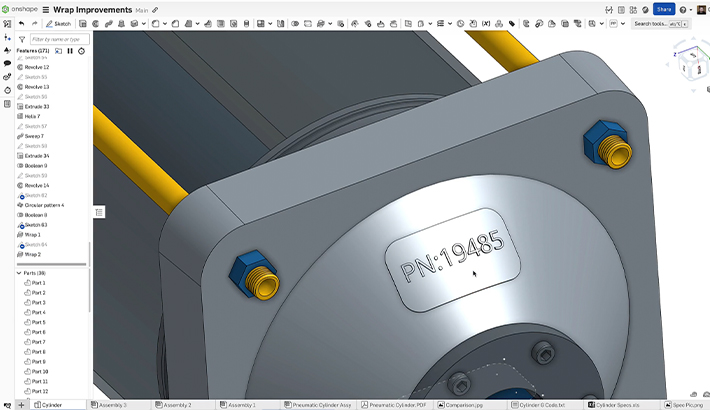Pockets achieve a balance between structural integrity and weight reduction, particularly in aerospace and automotive applications where minimizing mass is crucial. Additionally, pockets can house mechanical or electronic components or facilitate assembly. Engineers typically include fillets and chamfers in pockets to avoid sharp corners.
Machining Pockets in Onshape CAM Studio
Machining pockets may require changes to the default settings in CAM Studio. This Tech Tip gives you some guidance on what works better for machining pockets. Other aspects like drilling and tapping holes are ignored.
The Billet Side Cover example, shown below, illustrates this Tech Tip:

Getting Started with Onshape CAM Studio
This part has several pockets at multiple depths. The first step is to generate the toolpath to rough-cut material from all the pockets and holes. Before doing this, create a CAM Studio, and:
-
Create a Job for the CAM Simulation
-
Create a machine
-
Specify the setup
-
Create a tool

If you are unfamiliar with CAM Studio, the Learning Center provides a clear introduction to these four steps.
In Step 4, the end mill is created and used for roughing and profiling. For a part like this, machinists may choose to cut in several passes, starting with a larger tool. For the brevity of this Tech Tip, a 5mm diameter tool is used. This is small enough to cut all the features including the fillets.
Creating Toolpaths in Onshape CAM Studio
Create a toolpath for the Rough cut. Click on the Create toolpath icon as shown below:

In the Toolpath Strategy settings section, select Bodies from the Type dropdown. This lets you avoid having to select each pocket individually. Leave the Job bodies option enabled. This automatically selects the component indicated as the part to be machined while creating the CAM Studio.

For this example, change the following default settings:
-
Offset: 0.4 mm (down from 0.8 mm). This leaves 0.4 mm of material along the pocket interior after the rough cut is completed.

-
Step down type: Number of slices
-
Step down: 1.
The default calculates the step down as a percentage of the tool diameter. However, when chamfered edges are present this setting may not work well.

Leave the rest of the settings at their default values and click OK. You can now generate the toolpath.
Select the toolpath to visualize a number of helical paths downward. These are used to machine the pockets and holes.

Select Show/Hide operation stock to see the pockets are cut and the chamfers ignored in this first rough pass. This is the desired outcome.

Finish the pocket surfaces. Remember, there is 0.4 mm of material at the bottom and on the walls of the pockets. In this pass, the excess material from all the pockets is cut. As before, create another toolpath. In the Toolpath Strategy settings section, select Bodies as the Type and Flatlands as the Pattern.

In the Machining bodies settings section, turn off the Use job bodies option and select Pocket in the Selection filter dropdown, then select all the pockets to cut.

Duplicate the Flatlands toolpath, remove the pockets, and add a Contour in the Machining body. Select the face shown below. This removes the extra 0.4 mm of material from that face and ensures that the pockets are at the right depth.

Visualize the operation stock and the toolpath simultaneously. All the pockets are processed. The first Flatlands toolpath is visualized in green and the second is visualized in blue. Try running the verification simulation for both the Rough pass and the Flatlands pass (see the video at the bottom of this Tech Tip).

Chamfer the edges in the final pass. Click the Create tool icon to create a new Tool:

In the Cutter settings section, select Chamfer mill from the Cutter type dropdown.
Reduce the Shaft diameter to 4 mm and set the cutter's Diameter to 1.6 mm.

Create a toolpath. In the Strategy settings section, select Edges from the Type dropdown and 2-axis chamfer from the Pattern dropdown. In the Drive edges settings section, select Loop from the Selection filter dropdown. Then select the outer loops on the edges to be chamfered:

In the Offset settings section, set the Axial shift to 0.8 mm.

Visualize the operation stock. The chamfers are displayed in magenta.
Using these toolpaths, the pockets are now cut and the edges chamfered.

Continue working on this Billet Side Cover for drilling and tapping holes.
For more insights, review the most recent technical blogs here.
The Onshape
Learning Center
Take self-paced courses, get technical briefings,
watch informational webinars, or sign up
for an instructor-led training session.














